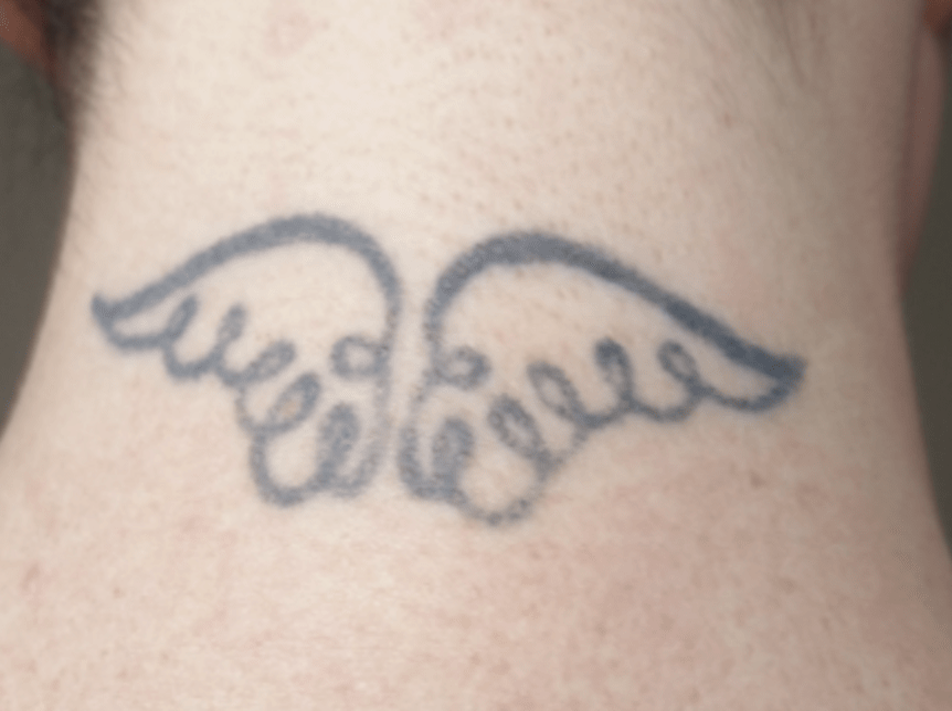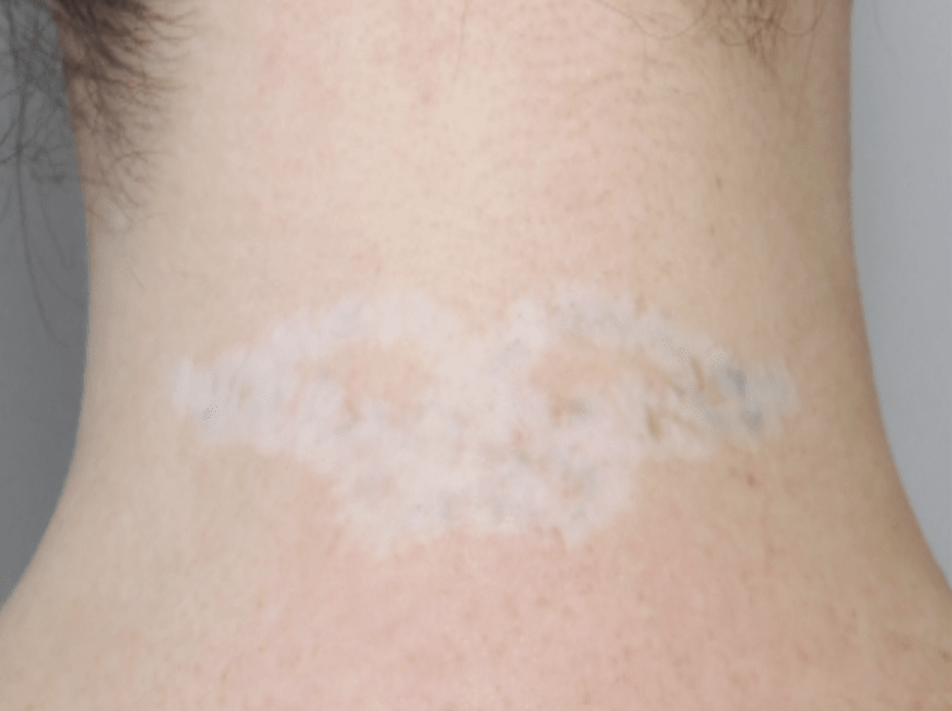What is Dermabrasion Tattoo Removal?

BEFORE

AFTER
Tattoos are a form of self-expression, but as life changes, so can our feelings about the ink we once wanted. When it’s time to make a change, there are several tattoo removal methods to consider. One increasingly popular option is dermabrasion tattoo removal, a non-laser alternative that offers unique benefits for those seeking a fresh start. We’re exploring what dermabrasion tattoo removal is, how it works, and how it compares to other methods like laser removal.
How Does the Procedure Work?
Dermabrasion tattoo removal is a non-laser technique that removes tattoos by gently abrading the epidermis (the upper layer of skin) to access and extract the ink. This method works in conjunction with your body’s natural healing process to remove the ink particles from your body, leaving the treated area ink-free after one session. Unlike lasers, dermabrasion doesn’t rely on the wavelength of light or extreme heat to break up the ink pigments, making it an excellent alternative for those seeking a different approach to tattoo removal.
The dermabrasion tattoo removal process involves the following steps:
Preparation: The area around the tattoo is thoroughly cleaned and prepped for treatment.
Treatment: A specialized dermabrasion device, like Tatt2Away, is used to exfoliate the epidermal layer of skin, exposing the ink beneath in the dermal layer. As the epidermis is exfoliated, a 100% natural ingredient solution, Teprsol, is deposited on the dermal layer allowing the ink pigments to be released from the dermis. The process is carefully controlled to ensure safety and efficacy.
Healing: Over the next several weeks, the body’s natural healing process takes over, gradually expelling the ink particles from the treated area in the form of scabs or eschars.
Follow–Up: Additional sessions may be needed, around 3-5 sessions using Tatt2Away, depending on the size of the tattoo.
Who is a Good Candidate for Dermabrasion Tattoo Removal?
Dermabrasion is an excellent option for many individuals, particularly those who:
- Have tattoos with vibrant or stubborn colors, such as greens, reds, whites, and blues, which can be challenging or impossible for lasers to remove.
- Want a prudent non-laser option due to skin sensitivity or concerns about heat-related side effects
- Are seeking partial removal for a cover-up tattoo or a tattoo revision
A consultation with a trained dermabrasion professional can help determine if dermabrasion is the right choice for your tattoo removal needs.
Benefits of Dermabrasion Tattoo Removal
There are several reasons why people choose dermabrasion over other tattoo removal methods:
Effective on All Ink Colors: Unlike lasers, which can struggle with certain hues, dermabrasion works on every ink color, and is effective on any skin tone.
Less Risk and Heat Damage: Dermabrasion avoids the heat-related risks associated with lasers, such as blistering, discoloration, or the processing of potentially harmful inks through the body’s lymphatic system that could cause an immune or allergic response.
Versatile: It’s suitable for complete removal, partial removal, or precise tattoo revisions.
Cost-Effective: Depending on the tattoo’s size and complexity, dermabrasion can require fewer sessions, potentially lowering overall costs. Most laser companies remove tattoos in 10-15 sessions, while companies that use dermabrasion, such as Tatt2Away, usually only require 3-5 sessions depending on the size of the tattoo.
What to Expect During the Healing Process
The healing process after dermabrasion is a vital part of achieving great results. Here’s what to expect:
Scabbing: After each treatment, scabs will form as part of the skin’s natural healing process.
Skin Renewal: Once the scabs fall off, the skin will appear red or pink as it regenerates. This is normal and is part of the body’s natural healing process!
Next Sessions: Approximately 6-8 weeks after your session, the skin should be healed and ready for your next session. Proper aftercare, including keeping the area clean and moisturized, is essential to ensure smooth healing and prevent complications. Make sure to ask your technician about proper aftercare and what that might require from you. Find more aftercare information for Tatt2Away’s precision dermabrasion technique.
Are There Any Risks or Side Effects?
As with any cosmetic procedure, there are some risks and potential side effects to consider. Temporary redness, swelling, or discomfort in the treated area could be expected. If proper aftercare is not followed, there is a slight risk of scarring or changes in skin texture. This could come from the risk of infection if the area is not kept clean during healing. Always choose a certified and experienced professional to significantly reduce these risks.
How Does Dermabrasion Compare to Laser Tattoo Removal?
When deciding between dermabrasion and laser tattoo removal, it’s essential to consider the differences:
Effectiveness: Dermabrasion works on all ink colors and skin tones, while lasers may struggle with certain hues like green and blue and may not be as effective on darker skin tones. Learn more about non-laser and the dot pattern that Tatt2Away uses.
Treatment Time: Dermabrasion often requires fewer sessions than laser treatments, depending on the tattoo’s size and ink density. With laser tattoo removal, it takes longer to remove a tattoo with ink that is densely packed, whereas ink density is irrelevant for dermabrasion tattoo removal.
Skin Impact: Dermabrasion avoids heat-related damage, reducing the risk of blistering or discoloration.
Cost Comparison: Fewer sessions can make dermabrasion a more budget-friendly option.
Suitability for Cover-ups: Dermabrasion offers precise ink removal or fading, making it ideal for tattoo revisions or cover-ups, with fewer sessions required than for laser tattoo removal.
Frequently Asked Questions
Does dermabrasion hurt?
Dermabrasion feels almost exactly like having a tattoo applied, but is usually shorter in duration than getting a tattoo. If the discomfort of treatment is too much, numbing agents may be applied at some studios.
How many sessions will I need?
The number of sessions depends on the size of the tattoo, but with Tatt2Away, most clients have full removal in 3-5 sessions, and significant removal to get a cover-up tattoo in just 1-2 sessions.
Will it completely remove my tattoo?
While dermabrasion is highly effective, complete removal depends on factors like the depth of tattoo ink pigments in dermis, proper aftercare, and number of sessions attended.
Can dermabrasion be used for tattoo revisions?
Yes, absolutely! Dermabrasion is ideal for partial removal or disrupting a pattern to create a clean slate for a new design.
Conclusion About Dermabrasion Tattoo Removal
Dermabrasion tattoo removal offers a safe, effective, and versatile alternative to other types of tattoo removal treatments. When considering the dermabrasion method, it is important to seek out professionals and consider what kind of removal you are looking for. If you are interested in partial tattoo removal for revisions or a coverup, Tatt2Away stands out as a leader, with our precision dermabrasion technique. Tatt2Away’s method introduces precision and effectiveness within the dermabrasion space. For the latest tattoo removal news and trends, check out our blog.
Whether you’re seeking full removal, partial removal for a cover-up, or precise tattoo revisions, Tatt2Away can help you achieve your goals. Ready to start your tattoo removal journey? Find a location near you and book a consultation today to see if dermabrasion tattoo removal is right for you! Our trained professionals are here to guide you every step of the way. Contact us now and embrace your fresh start!
